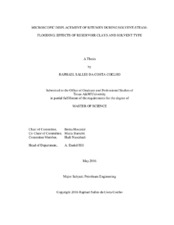| dc.description.abstract | Solvent-steam-flooding (SSF) processes have several advantages over steamflooding for bitumen extraction. It is well known that the addition of solvent increases oil production and mitigates environmental impacts due to steam generation. However, there exist numerous unknowns on the mutual interactions of solvent with steam, reservoir oil, and reservoir rock which affect the overall performance of the EOR method.
Through an experimental approach, this study investigates the microscopic displacement efficiency of SSF for the extraction of Peace River bitumen.
Two types of gas phase solvents were tested: hydrocarbon (propane) and nonhydrocarbon (carbon dioxide - CO2). Propane was chosen for its good solubility in oil, whereas CO2 was selected as an environmentally friendly option to decrease the project’s carbon footprint by re-injecting boiler combustion or associated gas.
Solvent flooding (CO2 flooding and propane flooding), steam-flooding, and SSF performances to extract Peace River bitumen were investigated with 12 one-dimensional core flooding experiments. Process performances were evaluated with cumulative oil recovery, sweep efficiency, produced oil and residual oil quality analyses.
To investigate the effect of reservoir fines (clays), experiments were performed with and without clays on the reservoir rock. The phase behavior of the solvent-crudeasphaltene interactions was also studied by analyzing asphaltene precipitation. Finally, the impacts of varying the solvent flowrate were also studied.
This research study suggests that CO2 or propane insoluble fractions (asphaltenes) decrease permeability and increase oil viscosity during solvent flooding due to their interactions with clays. These problems are enhanced by solvent-steam co-injection, which also causes the formation of emulsions. Clay migration to oil phase during production is more significant for propane-steam co-injection. It is believed that the polar nature of asphaltenes is the reason behind the interactions with clays and water. | en |


